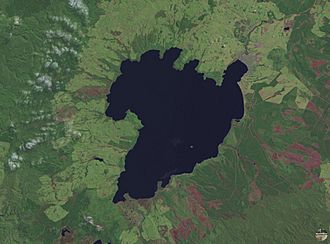Hatepe eruption facts for kids
Quick facts for kids Hatepe eruption |
|
|---|---|

|
|
| Volcano | Lake Taupo |
| Date | About 180 CE |
| Type | Phreatomagmatic, Ultra-Plinian |
| Location | Lake Taupo, North Island, New Zealand 38°49′S 175°55′E / 38.817°S 175.917°E |
| VEI | 7 |
| Impact | Devastated local vegetation, expanded Lake Taupo, flooded the Waikato River |
The Hatepe eruption, named for the Hatepe Plinian pumice tephra layer, sometimes referred to as the Taupo eruption and dated to either around 180 or 233 CE was Taupo Volcano's most recent major eruption. It is considered New Zealand's largest eruption during the last 20,000 years. The eruption ejected some 120 km3 (29 cu mi) of material, of which 30 km3 (7.2 cu mi) was ejected in a few minutes. This makes it one of the largest eruptions in the last 5,000 years, comparable to the Minoan eruption in the 2nd millennium BCE, the 946 eruption of Paektu Mountain, the 1257 eruption of Mount Samalas, and the 1815 eruption of Mount Tambora.
Stages of eruption
The eruption went through several stages, with six distinct marker horizons identified. Despite the uniform composition of the erupted magma, a wide variety of eruptive styles were displayed, including weak phreatomagmatism, Plinian eruptions, and a huge pyroclastic flow. Rhyolitic lava domes were extruded some years or decades later, forming the Horomatangi reefs and Waitahanui bank.
The main pyroclastic flow devastated the surrounding area, climbing over 1,500 m (4,900 ft) to overtop the nearby Kaimanawa Ranges and Mount Tongariro, and covering the land within 80 km (50 mi) with ignimbrite. Since New Zealand was not settled by the Māori until more than 1,000 years later, the area had no known human inhabitants when the eruption occurred. Tsunami deposits of the same age have been found on the central New Zealand coast, evidence that the eruption caused local tsunamis, but much more widespread waves may have been generated (like those observed after the 1883 Krakatoa eruption).
The Hatepe eruption further expanded the lake that had formed after the much larger Oruanui eruption around 26,500 years ago. The previous outlet was blocked, raising the lake 35 metres above its present level until it broke out in a huge flood, flowing for more than a week at roughly 200 times the Waikato River's current rate.
Dating the event
For many years it was believed, following research by Colin J. N. Wilson and others, that the eruption could be dated to exactly 186 CE. This meant that it coincided with meteorological phenomena described by Fan Ye in Han China and by Herodian of Antioch in the Roman Empire. This is now questioned.
Estimated dates previously suggested for the Taupo eruption have ranged from 131 to 233 CE. The earlier date was based on 14C from carbonized vegetation enclosed in the eruption products. However, the 22 selected samples used to obtain an average date of 1,819 ± 17 years BP (131 CE) had much larger standard deviations than the average date itself. Most, if not all, geologists now accept that the tephra or pumice fall from the eruption was far greater than previously thought, approximately 150 km3 (36 cu mi) instead of 14 km3 (3.4 cu mi). The later date of 233 CE ± 13 years (95% confidence) was a result of radiocarbon dating by R. Sparks (1995). The presence of contaminating 14C-less magmatic carbon in pre-eruption groundwaters has been proposed as skewing towards older dates, leading to suggested dates for the Hatepe eruption decades or even centuries younger than previously thought.
Humans had not settled in New Zealand at the time of the eruption, and would not for more than 1,000 years. The nearest human populations at the time were in Tonga, more than 1,700 km (1,100 mi) to the northeast.
See also
 In Spanish: Erupción de Hatepe para niños
In Spanish: Erupción de Hatepe para niños

